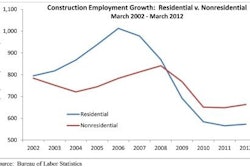Construction employment remains below peak levels in 329 out of 337 metro areas, according to analysis by the Associated General Contractors of America. Given the continued weakness in construction employment, the association urged Congress to pass years-late infrastructure measures, including legislation to fund highway, transit and aviation construction work.
"What makes these job losses even more frustrating is the fact that many of them could have been avoided," said the association's chief executive officer, Stephen E. Sandherr. "Thousands more construction workers would be employed today if Congress wasn't years late in passing measures like the highway and transit bill."
Sandherr noted that the Phoenix-Mesa-Glendale, Ariz. area lost more construction jobs since its peak employment (down 93,600 jobs compared to December 2006; a 53% drop) than any other metro area. Other areas experiencing large declines in construction employment compared to peak levels include:
- Riverside-San Bernardino-Ontario, Calif. (-73,700 jobs vs. December 2005; -57%)
- Las Vegas-Paradise, Nev. (-65,900 jobs vs. December 2005; -62%)
- Chicago-Joliet-Naperville, Ill. (-64,800 jobs; -35%)
Lake Havasu City-Kingman, Ariz. lost the highest percentage of jobs (-70%, -5,300 jobs vs. December 2005).
In contrast, only six areas have more people working in construction than ever before:
- Bismarck, N.D. (+400 jobs vs. December 2010,; +11%)
- Lawton, Okla. (+100 jobs vs. December 2010; +5%)
- Longview, Texas (+600 jobs vs. December 2010; +4%)
- Houma-Bayou Cane-Thibodaux, La. (+100 jobs vs. December 2010; +2%)
- Waco, Texas (+100 jobs vs. December 2008; +2%)
- El Paso, Texas (+100 jobs vs. December 2009; +1%)
Sandherr noted that the employment figures would have been higher had Congress not been years late in passing key infrastructure investment bills including a multiyear surface transportation bill that funds highway and transit construction projects nationwide. The association is working with groups such as the U.S. Chamber of Commerce to push for passage of a new, fully-funded surface transportation bill as part of an effort called "Make Transportation Job #1."
He also encouraged public officials to consider many of the measures the association outlined in its construction industry recovery plan, "Building a Stronger Future," designed to boost private-sector demand. "Our economy will never truly bounce back until construction employment begins to approach peak levels in most of our communities."
View the new construction employment figures by state or by rank.
Note: Comparisons are between December 2011 and previous December data to avoid distortions caused by seasonal variations due to weather or holidays. The Bureau of Labor Statistics does not provide seasonally adjusted data for metro areas. Construction is combined with mining and logging in most metros to prevent disclosure of data about industries with few employers.


















